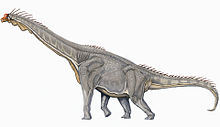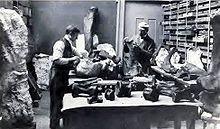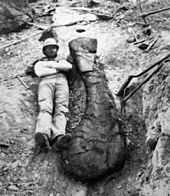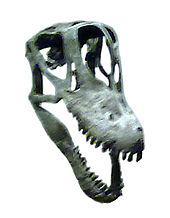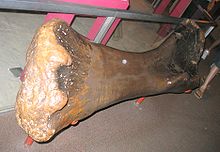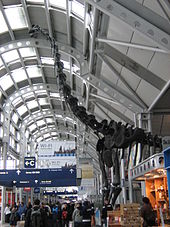
Brachiosaurus
Background to the schools Wikipedia
This Wikipedia selection is available offline from SOS Children for distribution in the developing world. Do you want to know about sponsoring? See www.sponsorachild.org.uk
| Brachiosaurus Temporal range: Late Jurassic, 154–153Ma |
|
|---|---|
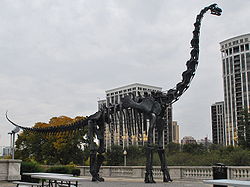 |
|
| Mounted skeleton cast, Field Museum of Natural History | |
| Scientific classification |
|
| Kingdom: | Animalia |
| Phylum: | Chordata |
| Class: | Reptilia |
| Order: | Saurischia |
| Clade: | †Sauropodomorpha |
| Clade: | †Sauropoda |
| Clade: | †Titanosauriformes |
| Family: | †Brachiosauridae |
| Genus: | †Brachiosaurus Riggs, 1903 |
| Species: | †B. altithorax Riggs, 1903 |
Brachiosaurus /ˌbrækiəˈsɔrəs/ is a genus of sauropod dinosaur from the Jurassic Morrison Formation of North America. It was first described by Elmer S. Riggs in 1903 from fossils found in the Grand River Canyon (now Colorado River) of western Colorado, in the United States. Riggs named the dinosaur Brachiosaurus altithorax, declaring it "the largest known dinosaur". Brachiosaurus had a proportionally long neck, small skull, and large overall size, all of which are typical for sauropods. However, the proportions of Brachiosaurus are unlike most sauropods. The forelimbs were longer than the hindlimbs, which result in a steeply inclined trunk, making the overall body shape reminiscent of a modern giraffe. Also, while the tail is a typical long dinosaur tail, it was relatively short for a sauropod.
Brachiosaurus is the namesake genus of the family Brachiosauridae, which includes a handful of other similar sauropods. Much of what is known by laypeople about Brachiosaurus is in fact based on Giraffatitan brancai, a species of brachiosaurid dinosaur from the Tendaguru Formation of Tanzania that was originally described by German paleontologist Werner Janensch as a species of Brachiosaurus. Recent research shows that the differences between the type species of Brachiosaurus and the Tendaguru material are significant enough that the African material should be placed in a separate genus. Several other potential species of Brachiosaurus have been described from Africa and Europe, but none of them are thought to belong to Brachiosaurus at this time.
Brachiosaurus is one of the rarer sauropods of the Morrison Formation. The type specimen of B. altithorax is still the most complete specimen, and only a relative handful of other specimens are thought to belong to the genus. It is regarded as a high browser, probably cropping or nipping vegetation as high as possibly 9 metres (30 ft) off of the ground. Unlike other sauropods, and its depiction in Jurassic Park, it was unsuited for rearing on its hindlimbs. It has been used as an example of a dinosaur that was most likely ectothermic due to its large size and the corresponding need for forage, but more recent research finds it to have been warm-blooded.
Description
Like all sauropod dinosaurs, Brachiosaurus was a quadrupedal animal with a small skull, a long neck, a large trunk with a high-ellipsoid cross section, a long, muscular tail and slender, columnar limbs. The skull had a robust, wide muzzle and thick jaw bones, with spoon–shaped teeth. As in Giraffatitan, there was an arch of bone over the snout and in front of the eyes that encircled the nasal opening, although this arch was not as large as in its relative. Large air sacs connected to the lung system were present in the neck and trunk, invading the vertebrae and ribs, greatly reducing the overall density. Unusually for a sauropod, the forelimbs were longer than the hind limbs. The humerus (upper arm bone) of Brachiosaurus was relatively lightly built for its size, measuring 2.04 metres (6.7 ft) in length in the type specimen. The femur (thigh bone) of the type specimen was only 2.03 metres (6.7 ft) long. Unlike other sauropods, Brachiosaurus appears to have been slightly sprawled at the shoulder joint, and the ribcage was unusually deep. This led to the trunk being inclined, with the front much higher than the hips, and the neck exiting the trunk at a steep angle. Overall, this shape resembles a giraffe more than any other living animal.
Size
Because "Brachiosaurus" brancai (Giraffatitan) is known from much more complete material than B. altithorax, most size estimates for Brachiosaurus are actually for the African form. There is an additional element of uncertainty for North American Brachiosaurus because the most complete skeleton appears to have come from a subadult. Over the years, the mass of B. altithorax has been estimated as 35.0 metric tons (38.6 short tons), 43.9 metric tons (48.4 short tons), and, most recently, 28.7 metric tons (31.6 short tons). In the first and last cases, the authors also provided estimates for Giraffatitan, and found that genus to be somewhat lighter (31.5 metric tons (34.7 short tons) for Paul [1988] and 23.3 metric tons (25.7 short tons) for Taylor [2009]). The length of Brachiosaurus has been estimated at 26 metres (85 ft).
Classification
Brachiosaurus is the namesake genus of Brachiosauridae. Over the years a number of sauropods have been assigned to Brachiosauridae, such as Astrodon, Bothriospondylus, Dinodocus, Pelorosaurus, Pleurocoelus, and Ultrasaurus, but most of these are currently regarded as dubious or of uncertain placement. A phylogenetic analysis of sauropods published in the description of Abydosaurus found that genus to form a clade with Brachiosaurus and Giraffatitan (included in Brachiosaurus). A more recent analysis focused on possible Asian brachiosaurid material found a clade including Abydosaurus, Brachiosaurus, Cedarosaurus, Giraffatitan, and Paluxysaurus, but not Qiaowanlong, the putative Asian brachiosaurid. Related genera include Lusotitan and Sauroposeidon. Brachiosauridae is situated at the base of Titanosauriformes, a group of sauropods that also includes the titanosaurs.
According to the revised diagnosis by Taylor Brachiosaurus altithorax is diagnosed by a plethora of characters, many to be found on the dorsal (back) vertebrae. Among the characters playing it in the family Brachiosauridae are a ratio of humerus to femur length greater or equal to 0.9 (i.e., the upper arm bone is at least nearly as long as the thigh bone), and a very flattened femur shaft (ratio ≥1.85).
Discovery and history
The genus Brachiosaurus, and type species B. altithorax, are based on a partial postcranial skeleton from Fruita, in the valley of the Colorado River of western Colorado. This specimen was collected from rocks of the Brushy Basin Member of the Morrison Formation in 1900 by Elmer S. Riggs and his crew from the Field Columbian Museum (now the Field Museum of Natural History) of Chicago. It is currently cataloged as FMNH P 25107. Riggs and company were working in the area as a result of favorable correspondence between Riggs and S. M. Bradbury, a dentist in nearby Grand Junction. In 1899 Riggs had sent inquiries to rural locations in the western United States concerning fossil finds, and Bradbury, an amateur collector himself, reported that dinosaur bones had been collected in the area since 1885. It was Riggs' field assistant H. W. Menke who found FMNH P 25107, on July 4, 1900. The locality, Riggs Quarry 13, was found on a small hill later known as Riggs Hill; it is marked by a plaque. Additional Brachiosaurus fossils are reported on Riggs Hill, but other fossil finds on the hill have been vandalized. Riggs published a short report in 1901, noting the unusual length of the humerus compared to the femur and the extreme overall size and the resulting giraffe-like proportions, as well as the lesser development of the tail, but did not publish a name for the new dinosaur. The titles of Riggs (1901) and (1903) suggested that the specimen was the largest known dinosaur. Riggs followed his 1903 publication that named Brachiosaurus altithorax with a more detailed description in a monograph in 1904.
The Fruita skeleton was not the first discovery of Brachiosaurus bones, although it was the first to be recognized as belonging to a new and distinct animal. In 1883, a sauropod skull was found near Garden Park, Colorado, at Felch Quarry 1, and was sent to Othniel Charles Marsh (of " Bone Wars" fame). Marsh incorporated the skull into his skeletal restoration of "Brontosaurus" (now Apatosaurus). It eventually became part of the collections of the National Museum of Natural History, as USNM 5730. In the 1970s, when Jack McIntosh and David Berman were working on the issue of the true skull of Apatosaurus, they reevaluated the Garden Park skull as more similar to Camarasaurus. It was described and recognized as a Brachiosaurus skull in 1998 by Kenneth Carpenter and Virginia Tidwell, intermediate in form between Camarasaurus and Giraffatitan brancai (then still considered to be B. brancai). Because there are no overlapping parts between this skull and FMNH P 25107, it cannot be confidently assigned to a species, so it is classified as Brachiosaurus sp.
Additional discoveries of Brachiosaurus material in North America have been uncommon and consist of a handful of bones. Material has been described from Colorado, Oklahoma, Utah, and Wyoming, and undescribed material has been mentioned from several other sites. One of these specimens, a shoulder blade from Dry Mesa Quarry, Colorado, is one of the specimens at the centre of the Supersaurus/Ultrasauros issue of the 1980s and 1990s. In 1985, James A. Jensen described disarticulated sauropod remains from the quarry as belonging to several taxa, including the new genera Supersaurus and Ultrasaurus, the latter renamed Ultrasauros shortly thereafter because another sauropod already had the name. Later study showed that the "ultrasaur" material mostly belonged to Supersaurus, although the shoulder blade did not. Because the holotype of Ultrasauros, a back vertebra, was one of the specimens that was actually from Supersaurus, the name Ultrasauros is a synonym of Supersaurus. The shoulder blade is now assigned to Brachiosaurus, but the species is uncertain. In addition, the Dry Mesa "ultrasaur" was not as large as had been thought; the dimensions of the shoulder's coracoid bone indicate that the animal was smaller than Riggs' original specimen of Brachiosaurus.
Etymology
Riggs derived the genus name from the Greek brachion/βραχιων meaning "arm" and sauros/σαυρος meaning "lizard", because he realized that the length of the arms was unusual for a sauropod. The species epithet "altithorax" was chosen because of the unusually deep and wide chest cavity, from Latin altus meaning "deep" and Greek thorax/θώραξ (Latin thorax), meaning "breastplate, cuirass, corslet".
Species
Brachiosaurus altithorax
FMNH P 25107, the holotype of both the genus Brachiosaurus and the species B. altithorax, consists of the right humerus (upper arm bone), the right femur (thigh bone), the right ilium (a hip bone), the right coracoid (a shoulder bone), the sacrum (fused vertebrae of the hip), the last seven thoracic (trunk) and two caudal (tail) vertebrae, and a number of ribs. Riggs described the coracoid as from the left side of the body, but restudy has shown it to be a right coracoid.
Other assigned species
- "B." atalaiensis: Originally described by de Lapparent and Zbyszewski, this material's reference to Brachiosaurus was doubted by Upchurch, Barret and Dodson, who listed it as an unnamed brachiosaurid, and placed in its own genus Lusotitan by Antunes and Mateus. De Lapparent and Zbyszewski described a series of remains but did not designate a type specimen. Antunes and Mateus selected a partial postcranial skeleton ( MIGM 4978, 4798, 4801–4810, 4938, 4944, 4950, 4952, 4958, 4964–4966, 4981–4982, 4985, 8807, 8793–87934) as a lectotype; this specimen includes 28 vertebrae, chevrons, ribs, a possible shoulder blade, humeri, forearm bones, partial left pelvis, lower leg bones, and part of the right ankle. The low neural spines, the prominent deltopectoral crest of the humerus (a muscle attachment site on the upper arm bone), the elongated humerus (very long and slender), and the long axis of the ilium tilted upward indicate that Lusotitan is a brachiosaurid.
- "B." brancai: Janensch based his description on "Skelett S" (skeleton S) from Tendaguru, but later realized that it comprised two partial individuals: S I and S II. He did not designate them as a syntype series, nor specify a lectotype, and Taylor proposed the larger and more complete S II (MB.R.2181) as the lectotype. It includes, among other bones, several dorsal (trunk) vertebrae, the left scapula, both coracoids, both sternals (breastbones), both humeri, both ulna and radii (lower arm bones), a right hand, a partial left hand, both pubes (a hip bone) and the right femur, tibia and fibula (shank bones). A re-assessment of the relation between the African and American brachiosaur material indicates that a separate generic name is warranted for the Tendaguru material, meaning that it now is considered to belong to Giraffatitan.
- "B." fraasi: erected by Janensch in 1914, but later synonymized with "B." brancai; this material now belongs to Giraffatitan.
- "B." nougaredi: This species is known from fragmentary remains discovered in eastern Algeria, in the Sahara Desert. The present type material consists of a sacrum and some of the left metacarpals and phalanges. Found at the discovery site but not collected were partial bones of the left forearm, wrist bones, a right shin bone, and fragments that may have come from metatarsals. de Lapparent, who described and named the material in 1960, reported the discovery locality as being in the Late Jurassic–age Taouratine Series (he assigned the rocks this age in part because of the presumed presence of Brachiosaurus), but more recent review assigns it to the " Continental intercalaire," which is considered to be of Albian age (late Early Cretaceous, significantly younger). This material was found disjointed over an area of several hundred meters. Upchurch, Barrett and Dodson (2004) doubted its assignment to Brachiosaurus, and listed it as an unnamed brachiosaurid. The sacrum is of notable size, with a length of 130 centimetres (51 in) for four vertebrae compared to 95 centimetres (37 in) for five vertebrae in B. altithorax; other bones are not of unusual size in comparison to B. altithorax or Giraffatitan brancai.
Referred material
Taylor (2009) lists a number of specimens referred to Brachiosaurus. These include some material, e.g., a humerus from Potter Creek and some Dry Mesa material (the latter partly described as Ultrasauros by Jensen), that are either clearly not brachiosaurid in origin, or at least not clearly referable to Brachiosaurus. In contrast, a cervical (neck) vertebra and the skull mentioned above may belong to either B. altithorax or an as-yet unknown brachiosaurid from North America. The cervical was found near Jensen, Utah, by Jensen, and – if it belongs to Brachiosaurus – is one of a handful of neck vertebrae known for American brachiosaurids. There is no unambiguous material of the skull, neck, anterior dorsal (forward trunk) region, distal (lower) limbs or feet. More recently, Carballido et al. (2012) reported on a nearly complete postcranial skeleton of a juvenile sauropod (approximately 2 metres (6.6 ft) long) from the Morrison Formation of the Bighorn Basin, north-central Wyoming. This specimen was originally thought to belong to a diplodocid, but the authors reinterpreted it as representing a brachiosaurid, probably Brachiosaurus altithorax.
There was ample material referred to "B." brancai in the collections of the Museum für Naturkunde Berlin, some of which was destroyed during World War II. Other material was transferred to other institution throughout Germany, some of which was also destroyed. Additional specimens are likely among the material collected by the British Museum of Natural History's Tendaguru expedition. Much or all of this material probably belongs to Giraffatitan, although some may represent a new brachiosaurid.
Separation from Giraffatitan
When describing the brachiosaurid material from Tendaguru in 1914, Janensch listed a number of differences and commonalities between them and B. altithorax. In three further publications in 1929, 1950 and 1961 Janensch compared the two species in more detail, listing 13 putative shared characters. Of these, however, only four appear to be valid, while six pertain to more inclusive groups than Brachiosauridae, and the rest are either difficult to assess or refer to material that is not Brachiosaurus.
In 1988, Gregory Paul published a new reconstruction of the skeleton of "B." brancai, highlighting a number of differences in proportion between it and B. altithorax. Chief among them is a difference in the way the trunk vertebrae vary: they are fairly uniform in B. altithorax, but vary widely in the African material. Paul believed that the limb and girdle elements of both species were very similar, and therefore suggested to separate them not at genus, but only at subgenus level.
Giraffatitan was raised to genus level by Olshevsky without comment. A detailed study of all material, including the limb and girdle bones, by Michael Taylor in 2009 found that there are significant differences between Brachiosaurus altithorax and the Tendaguru material in all elements known from both species. Taylor found 26 distinct osteological (bone-based) characters, a larger difference than that between, e.g., Diplodocus and Barosaurus, and therefore argued that the African material should be placed in its own genus, Giraffatitan, as G. brancai. An important difference between the two genera is the overall body shape, with Brachiosaurus having a 23% longer dorsal (trunk) vertebrate series and a 20 to 25% longer and also taller tail.
Paleoecology
With the removal of the East African Giraffatitan, Brachiosaurus is known only from the Morrison Formation of western North America. The Morrison Formation is interpreted as a semiarid environment with distinct wet and dry seasons, and flat floodplains. Vegetation varied from gallery forests (river–lining forests in otherwise treeless settings) of conifers, tree ferns, and ferns, to fern savannas with rare Araucaria-like trees. Several other sauropod genera were present in the Morrison Formation, with differing body proportions and feeding adaptations. Among these were Apatosaurus, Barosaurus, Camarasaurus, Diplodocus, Haplocanthosaurus, and Supersaurus. Brachiosaurus was one of the less abundant Morrison Formation sauropods. In a survey of over 200 fossil localities, John Foster reported 12 specimens of the genus, comparable to Barosaurus (13) and Haplocanthosaurus (12), but far fewer than Apatosaurus (112), Camarasaurus (179), and Diplodocus (98). Brachiosaurus fossils are found only in the lower-middle part of the expansive Morrison Formation (stratigraphic zones 2-4), dated to about 154-153 million years ago, unlike many other types of sauropod which have been found throughout the formation.
Paleobiology
Neck position
In contrast to most other sauropods, brachiosaurids had an inclined back, due to their long forelimbs. Therefore, if the neck exited the body in a straight line, it already pointed upwards. The exact angle is influenced by how the pectoral girdle is reconstructed, that is how the shoulder blades are placed on the ribcage. The mobility of the neck was reconstructed as quite low by Stevens and Parrish, while other researchers like Paul and Christian and Dzemski argued for more flexible necks.
Feeding ecology
Brachiosaurus is thought to have been a high browser, feeding on foliage well above the ground. Even if it did not hold its neck near vertical, and instead had a straighter neck, its head height may still have been over 9 metres (30 ft) above the ground. It probably fed mostly on foliage above 5 metres (16 ft). This does not preclude the possibility that it also fed lower at times, between 3 to 5 metres (9.8 to 16 ft) up. Its diet likely consisted of ginkgos, conifers, tree ferns, and large cycads, with intake estimated at 200 to 400 kilograms (440 to 880 lb) of plant matter daily. However, more recent studies estimate that ~240 kilograms (530 lb) of plant matter would have been sufficient to feed a 70 metric tons (77 short tons) sauropod, so Brachiosaurus may have required only about 120 kilograms (260 lb) of fodder a day. Brachiosaur feeding involved simple up–and–down jaw motion. The teeth were arranged to shear material as they closed, and were probably used to crop and/or nip vegetation.
It has repeatedly been suggested, e.g. in the movie Jurassic Park, that Brachiosaurus could rear into a bipedal or tripodal (with tail support) pose to feed. However, a detailed physical modelling-based analysis of sauropod rearing capabilities by Heinrich Mallison showed that while many sauropods could rear, the unusual brachiosaurid body shape and limb length ratio made them exceptionally ill suited for rearing. The forward position of the centre of mass would have led to problems with stability, and required unreasonably large forces in the hips to obtain an upright posture. Brachiosaurus would also have gained relatively little from rearing (only 33% more feeding height), compared to other sauropods, for which a bipedal pose may have tripled the feeding height.
Metabolism
Like all sauropods, Brachiosaurus was homeothermic (maintaining a stable internal temperature) and endothermic (controlling body temperature through internal means), meaning that it was able to actively control its body temperature, producing the necessary heat through a high basic metabolic rate of its cells. In the past, Brachiosaurus has been used an example of a dinosaur for which endothermy is unlikely, because of the combination of great size (leading to overheating) and great caloric needs to fuel endothermy. However, these calculations were based on incorrect assumptions about the available cooling surfaces (the large air sacs were not known), and a grossly inflated body mass. These inaccuracies resulted in overestimation of heat production and underestimation of heat loss. The large nasal arch has been postulated as an adaptation for cooling the brain, as a surface for evaporative cooling of the blood. Again, when this was proposed, cooling via the air sacs was not known, and thus not taken into account. Furthermore, other similar sized sauropods had no comparable structure. Additionally, in proportion to the entire animal, the nasal arch is very small, and would thus have made only an insignificant contribution to heat loss.
In culture
The original Brachiosaurus specimens collected by Elmer Riggs for the Field Museum of Natural History (Chicago) were not put on display in the museum until 1994, when a skeletal mount (made up of resin casts rather than actual fossil bones) was constructed inside the museum's main Stanley Field Hall. The mount stood until 1999, when it was moved to the B Concourse of United Airlines' Terminal One in O'Hare International Airport. At the same time, a second cast (in bronze) of the Field Museum's B. altithorax was constructed outside the museum.
Brachiosaurus is one of the best-known dinosaurs amongst both paleontologists and the general public. A main belt asteroid, 1991 GX7, has been named 9954 Brachiosaurus in honour of the genus. The genus has been featured in many films and television programs, most notably the Jurassic Park and Walking with Dinosaurs series. The digital model of Brachiosaurus used in Jurassic Park went on to become the starting point for the ronto models in the 1997 special edition of the science fiction film Star Wars Episode IV: A New Hope.
